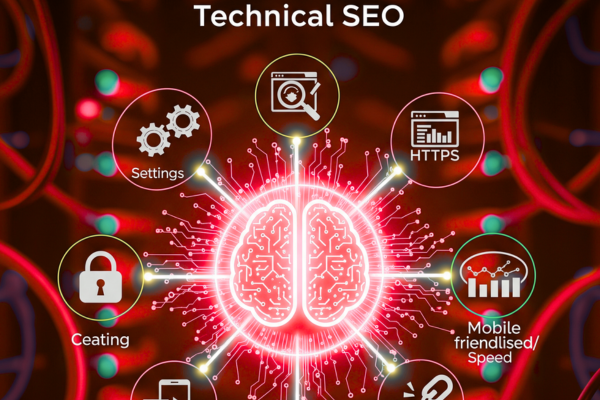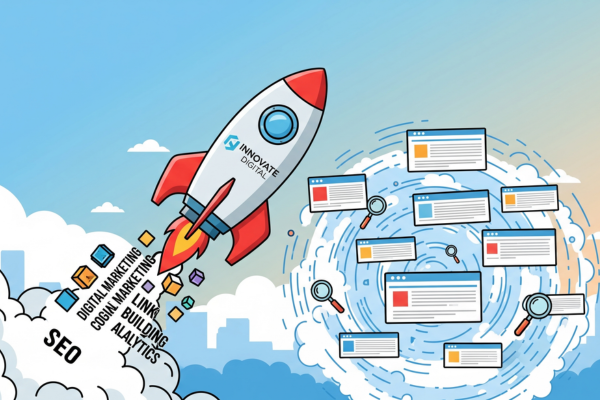When you first start your business it can be an exhilarating experience, but it can be overwhelming to get recognized in a seemingly overflowing digital world. You have the best product or service but ultimately no one can find your website. That is where SEO, or search engine optimization comes into play, SEO to boost their online presence can be a startup’s best friend.
Why SEO is a Startup’s Best Friend
This guide is your “SEO for Students” guide for anyone new to the field of business, breaking down how a startup could utilize SEO to grow their online presence. We will break down long-winded and complicated concepts into short and simple and straightforward steps to help get your startup in front of people’s eyes without depending too much on expensive advertisements.
What is SEO?
SEO is, simply, the process of improving visibility in search engines such as Google, Bing, and Yahoo. When someone performs searches for items related to your business, you want your site to appear in the search results at the highest position possible because most users never click on the second page. Ultimately, SEO is about helping search engines understand what your site is about so they can display it to the proper users.
Important of SEO for Startups
When a startup is getting underway, they tend to have very little cash, which is part of the reason the importance of SEO is so high. If a startup spends $500 on pay-per-click (PPC) advertising to generate traffic to their site, the moment they stop paying for that advertisement, it generates zero traffic. In contrast, when a startup invests $500 worth of time and effort improving their SEO, that $500 worth of work continues to give them static free organic traffic over time (considerably cheaper in the long run). In other words, SEO is a very cheap way for a startup to gain visibility and credibility and establish an online presence. It is essentially an “investment” that continues to give back over time.
The Three Pillars of SEO
In order for startups to effectively utilize SEO to grow their online presence, they should understand the three primary components: On-Page SEO, Technical SEO, and Off-Page SEO. These three components represent three legs of a stool, which means they need to do all three well in order for their strategy to work. We will discuss each of the three in simple terms.
Pillar 1: On-Page SEO – Polishing Your Website
On-Page SEO represents the things you can do on your website to optimize your content for search engines and consumers.
The first way is by using Keywords.

Keywords are the words and phrases consumers type into search engines. If a startup hopes to take significant advantage of SEO to grow its online presence, they will need to know the best keywords.
keywords to use. For example, if a start-up is selling handmade jewelry, the keywords they will likely use would be “handmade silver necklaces”, and “artisan unique earrings”.
– How to do this? Brainstorm what your customers may be looking for. You can also use free tools like the Google Keyword Planner to help you think of keywords:
– How to use them? If appropriate use your main keywords throughout the content. DO NOT “stuff” your keywords every where, as this will come off as spammy and hurt your ranking.
Writing Engaging Title Tags & Meta Descriptions:
-The Title Tag is the clickable headline in your search result and the meta description is the short description underneath it. A title tag and meta description allow you to entice your customer into clicking on your website.
-Title Tags: Use your main keyword on it and make it engaging/interesting. You can think of your title tag like the headline in a news article.
-Meta Descriptions: Write a short, engaging sentence or two that you think will entice people to click. You can think of it like a mini advertisement.
Writing Great, Useful Content
Content is king! Search engines reward great, useful content that adequately answers the user’s question with visibility. Your blog post is a great, useful piece of content, just like this Guide to SEO for Students.
. Account for your audience: Look at your content from the standpoint of solving your customers’ problems or answering their specific questions.
. Be an authority: You are the authority. Share what you know. Don’t just regurgitate facts, share your ideas and ideas from your story with it.
Uses of Headings and Subheadings
Headings (H1, H2, H3…) are like chapters in a book. They break up your content into segments or headings that allow the reader to scan easily through it.
H1: You can only use one H1 on a page. The H1 should contain your primary keyword.
H2 and H3: Use H2s for major headings and H3s for sub-headings. This will help search
engines understand what your page is about and it also makes it easy for readers to quickly skim through your content.
Pillar 2: Technical SEO: The Engine Under the Hood

Technical SEO addresses all the ” behind the scenes” things that make your site hum; it basically makes sure that your site is built correctly so that search engines can easily find it and understand it’s value.
. Making Sure your Site is Fast and Mobile Friendly
Think about how YOU use the internet. Is there anything more irritating than a slow site? Search engines have the same feelings!!
. Page Speed: Fast websites made for a better experience for all users, and it is a significant ranking factor.
. Mobile Friendliness: Most people browse the internet on their phone – your site needs to display the mobile version correctly and function correctly on a mobile device.
Simplifying your Site for SEO to boost their online presence
Search engines use bots to read your pages to get an idea of the structure of your site. Technical SEO typically refers to all of the things that keep crawlers from fully crawling your site.
. Crawlability – Provide clean code and structure.
. Indexability – Let bugs index your pages. If you do not give search engines permission to index pages it will never be exposed to an audience and not be displayed in results.
(.) Sitemap and Robots.txt
These two files function as maps for search engines.
. Sitemap – A file that lists each of the important pages on your site. It helps search engines find everything on your site.
. Robot.txt – A simple way to tell search engine crawlers where they can and cannot go on your site.
Pillar 3: Off-Page SEO – Build your credibility
Off-page SEO covers everything you do away from your website that helps build trust and authority for your website. It is an important aspect of your overall offline SEO strategy to build or increase your reputation online.
What is a Backlink and Why are They Important?
A backlink is simply a reverse link to you from another website to yours. Search engines see these links as votes of confidence. The more quality backlinks from reputable sites linking to your website the more trustworthy your website is.
Create Quality Content that people will want to link to.
The best way to get backlinks is to make such great content that people will naturally want to link to it. Some examples include helpful guides, interesting research and viral infographics.
Thinking About Digital PR and Brand Mentions
Think of Digital PR as getting your startup mentioned on other websites, blogs, and news sites. Just mentioning your brand, even if it does not involve a link, will increase your reputation.

Putting It All Together: Plan of Action
If you want to get started quickly, why not use SEO as a way to gain exponential traffic for your startup? This plan is very easy and definitely doable.
Start with Keywords: Figure out what the primary words or phrases your site should be ranked for.
Optimize Your Pages: Go to your site and make sure the titles, meta descriptions, and headings are all relevant to your keywords.
Create a Blog: Now for the fun part! You will begin writing and create quality content according to your keyword research.
Check for Technical Issues: Verify that your site does not have technical issues by using Google Search Console or any of the other free tools.
Build Links: a) Share your content across all social media platforms, b) reach out to other bloggers to see if they are welcoming guest bloggers, and c) network with professional colleagues to get your message and link onto their radar.
Assessing Progress: Are You Making Progress?
SEO should not be viewed as a set it and forget it task. You should absolutely monitor your SEO progress.
. Google Analytics: This is a free, powerful and easy to use tool that will show you how much traffic you are getting and where it is coming from.
. Google Search Console: This is a tool that shows what keywords you are really ranking for first, and if you have any technical issues, it shows you how to fix them.
If you regularly check even just a couple of these monitoring tools, you will be able to tell if your tactics are working and if you need to change your strategy to be more effective.
Conclusion:
For any new startup, search engine optimization is not a choice, it is a necessity to increase your potential online presence and visibility. This is why SEO is the most powerful, and cost-effective way, to be found by your ideal customers. Understanding and working on the three pillars of SEO; on-page, technical and off-page strategies, while applying a simple and consistent practice, you will have the ability to create a solid online foundation your company can grow and prosper upon for many years to come. Get started now, and you will witness your online visibility take off!
FAQS
Q1. What is SEO and why is it important for Students to know?
Ans. SEO is short for Search Engine Optimization. In simple terms, it is the process of making websites or online content more discoverable by the search engines such as Google. For students, this is the key to getting your personal blog, online portfolio, or school assignments visible to a broader audience — including potential employers and professors.
Q2. Is SEO something a newbie can do?
Ans: Absolutely not! While SEO can be a little technical, the principles behind it are simple and logical. I have broken it down to 3 key elements that are all digestible; On-Page SEO (what’s on your page), Off-Page SEO (what others say about you), and Technical SEO (how your site works). Pretty much any student can learn the fundamentals, practice and get a quick understanding and pay off for your hard work.
Q3. Do I need to buy expensive tools in order to do SEO?
Ans: There are great paid tools and there are very great free tools to begin your SEO journey. There are so many completely free things like Google Search Console, Google Analytics, and Google Keyword Planner which are capable of providing a beginner with everything they need to start optimizing their content and start tracking their performance.
Q4. How long will it take to see results from SEO?
Ans: Think of SEO as a marathon rather than a sprint. SEO results are not immediate: you may have to wait for a certain amount of time before you see any results of significance. The time frame for this varies based on a few factors, such as keyword competition, and the notability of your content. In the end it completely falls upon you to be patient and stay the course in creating high quality, optimized content on a regular basis.
Q5. What is the one thing I should do to get started with SEO?
Ans: If there was one thing to do, the one thing it would be, would be to create high quality content that is valuable to the audience. Unfortunately, if your content is not of value, no amount of SEO will help you. High quality, well researched, easy-to-read and most importantly, content that answers the questions your audience has is the key to the success of any SEO strategy.

